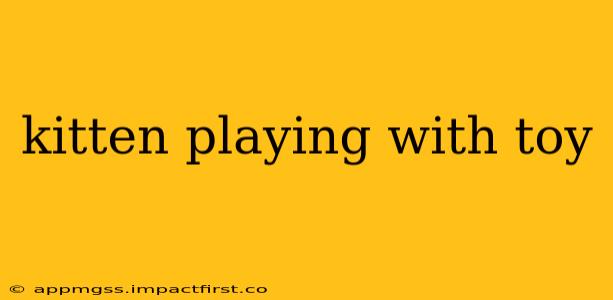The sight of a kitten batting at a toy is pure joy. It's more than just adorable; it's a crucial part of their development, a window into their playful nature, and a source of endless entertainment for us humans. Understanding why kittens play with toys, what kinds of toys are best, and how to safely engage in playtime is key to raising a happy, healthy, and well-adjusted cat.
Why Do Kittens Play with Toys?
Kittens aren't just engaging in frivolous fun; playing serves several important purposes:
-
Hunting Instincts: The playful pounce, the stalk, the ambush – these are all echoes of their wild ancestors' survival skills. Playing with toys helps them hone these instincts in a safe and controlled environment. This is vital for their development as effective hunters (even if their prey is a feather wand!).
-
Physical Development: Chasing, pouncing, and wrestling with toys strengthens their muscles, improves coordination, and enhances their agility. This physical exertion is essential for healthy growth and development.
-
Mental Stimulation: Playtime keeps their minds sharp. The challenge of catching a moving toy, solving a puzzle feeder, or figuring out how to bat a dangling string stimulates their problem-solving skills and keeps them mentally engaged. Boredom can lead to destructive behaviors, so playtime is a preventative measure.
-
Socialization: Interactive playtime with humans strengthens the bond between you and your kitten. It's a fantastic way to build trust and establish a positive relationship based on mutual affection and play.
What Types of Toys Do Kittens Enjoy?
Kittens have a wide variety of preferences, but some popular choices include:
-
Feathers and Wand Toys: These simulate the movement of prey, triggering their natural hunting instincts. Always supervise playtime with these toys to prevent ingestion of feathers.
-
Crinkle Balls: The crinkling sound is intriguing to kittens, and the small size is perfect for batting around.
-
Soft Plush Toys: These are great for cuddling and gentle play, offering a comforting alternative to more active games.
-
Puzzle Feeders: These challenge kittens to work for their food, stimulating their minds and providing enrichment.
How Often Should I Play with My Kitten?
Multiple short play sessions throughout the day are better than one long session. Aim for at least two to three 15-20 minute play sessions daily. Observe your kitten's energy levels; if they seem tired, it's time to wind down the playtime.
What if My Kitten Isn't Interested in Toys?
Some kittens are more playful than others. If your kitten isn't engaging with toys, try experimenting with different types and textures. A toy that mimics the movement of a mouse or a small, crinkly ball might pique their interest. You can also try using different play techniques, like hiding the toy and then revealing it dramatically.
Are There Any Dangers Associated with Kitten Toys?
Yes, there are some safety precautions to consider:
- Supervision: Always supervise playtime to prevent your kitten from ingesting small parts of toys.
- Toy Material: Avoid toys made of materials that could be toxic if ingested. Choose toys made of durable, non-toxic materials.
- String Toys: While enticing, string toys can pose a choking hazard if swallowed. Never leave string toys unattended.
How Can I Make Playtime More Engaging?
Vary the types of toys you offer to keep your kitten stimulated. Change up the location of playtime, moving from room to room to add novelty. You can also try incorporating different types of play, such as chase games, hide-and-seek, or interactive puzzle feeders.
By understanding your kitten's needs and providing appropriate playtime, you'll nurture their development, strengthen your bond, and create a lifetime of shared joy. Remember, playtime isn't just fun; it's an essential part of raising a happy and healthy cat.
